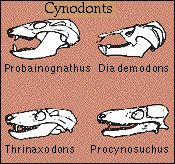Fossils and the history of life - How did mammals evolve?

The origin of the mammals can be traced back through a series of reptilian groups called the mammal-like reptiles.
This is an informal name for the reptilian group Synapsida. They evolved over an approximately 100 million year period from the Pennsylvanian to the end of the Triassic, when the first true mammals appear. The interesting feature of the evolution of the mammal-like reptiles, for our purposes, is what they suggest about how a major new group originates.
Three main phases in mammal-like reptilian evolution;
1. The first phase corresponds to one of the two major divisions of the group, the pelycosaurs. Pelycosaur fossils are preserved from the Pennsylvanian and Permian. Pelycosaurs lived there about 300 million years ago. The distinctive difference from other reptile groups is an opening in the bones behind the eye. The opening is called a temporal fenestra, and in the living animal a muscle passed through it. The muscle acted to close the jaw, and the opening up of the temporal fenestrae is the first sign of the more powerful jaw mechanism of the mammals.
2. The evolution of the therapsids makes up the second main phase of the mammal-like reptiles, in the Permian and Triassic. Therapsid fossils are found in many regions of the world. The therapsids have temporal fenestrae which are generally larger and more mammal-like than pelycosaurs; their teeth in some cases show more serial differentiation; and later forms had evolved a secondary palate. A secondary palate enables the animal to eat and breathe at the same time and is a sign of a more active, perhaps warm-blooded, way of life.
3. One sub-group of therapsids, the cynodonts (pictured opposite), make up the third phase of mammal-like reptilian evolution. The jaws of cynodonts resemble modern mammal jaws more closely and their teeth are multi-cusped and differentiated down the jaw. The cynodonts complete the story of the mammal-like reptiles, because it was from a line of cynodonts that the ancestors of the modern mammals evolved.
The following animation illustrates the evolution of the distinctive mammal jaw.
| Next |



